OF PATTERNS, ARCHIVES, AND RESISTANCE
This component is part of my research on archiving different expressions of resistance and on the patchwork quilt that serves as a temporary residence for it. Chosen for its links with cultural heritage and the history of protests, the quilt as a host for the elements of the archive deliminates and challenges the classic notion of an archive.
OF PATTERNS, ARCHIVES, AND RESISTANCE
Text In my research I explore the various symbolic and historical layers of places and events from the past and the present These traces of the events and places have been revised and reorganized into an archive The origin of certain archival materials is
In my research I explore the various symbolic and historical layers of places and events from the past and the present. These traces of the events and places have been revised and reorganized into an archive. The origin of certain archival materials is not authentic, yet it is presented as authentic. The work aims to identify forms of resistance by combining multiple visual elements such as images, graphics, sculptures, videos, and texts into one archive. This work is about protests, contradictions, power, speculations, fandoms, impossibilities, memories, time, propaganda, and spaces—it is about tracing resistance.
Text The word resistance has its origins in the Latin language It can be traced back to the Latin verb resistere which is a combination of re meaning against and sistere meaning to stand Resistere essentially means to stand against or to oppose It origina
The word "resistance" has its origins in the Latin language. It can be traced back to the Latin verb "resistere," which is a combination of "re-" (meaning "against") and "sistere" (meaning "to stand"). "Resistere" essentially means "to stand against" or "to oppose." It originally referred to the act of opposing or withstanding something, often in a physical sense. Over time, the concept of resistance has expanded beyond the physical realm to encompass various contexts, such as social, political, and more.
Text The topic of resistance is very broad It has received increasing attention in disciplines such as anthropology cultural studies geography political science and womens studies 1 In their article Conceptualizing Resistance Hollander and Einwohner write
The topic of resistance is very broad. It “has received increasing attention in disciplines such as anthropology, cultural studies, geography, political science, and women's studies”. (1) In their article “Conceptualizing Resistance” Hollander and Einwohner write that although there are many different phenomena that are described as resistance, “there is little consensus on the definition of resistance.” (2) When trying to outline its main characteristics, they conclude that at the center of these disagreements on definitions lay such categories as recognition and intent.
Text Resistance has many other forms besides physical and material such as symbolic behavior Further on in the section about patchwork quilts I give examples of this kind of resistance These include Womens Suffrage Movement 3 which used quilting technique
Resistance has many other forms besides physical and material, such as symbolic behavior. Further on in the section about patchwork quilts, I give examples of this kind of resistance. These include Women’s Suffrage Movement (3) which used quilting techniques to leave messages and support women with Suffrage banners and slogans, and The AIDS Memorial Quilt in Washington, D.C. made in memory of people with AIDS. As much as resistance can manifest itself by speaking up, it can as well in certain contexts manifest itself through silence. For example, when police search for protest participants, witnesses stay silent in solidarity with those being hunted.
Text Resistance works on different scales and acts of resistance may take individual and collective forms Resistance can have also multiple goals and directions and it would be a mistake to dismiss the complexity of such acts within the social order
Resistance works on different scales and acts of resistance may take individual and collective forms. Resistance can have also multiple goals and directions and it would be a mistake to dismiss the complexity of such acts within the social order.
Text Here I would like to elaborate a little bit on the form of collective resistance in politics The authors of the book Inventing the Future Nick Srnicek and Alex Williams believe that despite the popularity of the theme of resistance in various fields
Here I would like to elaborate a little bit on the form of collective resistance in politics. The authors of the book Inventing the Future Nick Srnicek and Alex Williams believe that despite the popularity of the theme of resistance in various fields, it is often associated with nostalgia. "If nostalgia for a lost past cannot be considered an adequate response, today's widespread glorification of resistance is no more adequate." (4) They talk about how, for example, horizontalism as an integral part of “folk politics” (5) is the main direction of modern left-radical politics, and it is based on left anarchism, "the practice of communist councils", and libertarian socialism. In modern conditions, horizontalists try to "change the world without taking power". They oppose any methods of state coercion and vertical structures, and are in favor of direct democracy and the principle of consensus. As an example of horizontalist politics, the authors cite the Occupy Wall Street movement and the experience of the Argentine crisis of 1999-2002. However, according to the authors, both movements quickly ran out of steam due to a lack of clear political requirements.
Image rawImagejpeg

Protesters representing the Occupy Wall Street movement rally Tuesday in New York City's Washington Square Park. Photo by Bebeto Matthews. Source: The Houston Chronicle
Text Part of my archive is documentation of the Umbrella Revolution in Hong Kong in 2014 The resistance movement did not achieve its goals either but it was a special experience for me not only because of the scale of the protests but also because of the
Part of my archive is documentation of the Umbrella Revolution in Hong Kong in 2014. The resistance movement did not achieve its goals either, but it was a special experience for me, not only because of the scale of the protests but also because of the organization and relationships inside the movement. I took part in the protests in Moscow before, but it was nothing like what I got to see in Hong Kong.
Image UMBRELLAREVOLUTION1jpg

Umbrella Revolution, Hong Kong 2014. Photo Liudmila Savelyeva
Text My collection which I call an archive encapsulates different forms of resistance In some cases I become a passive observer in some cases an investigative detective and sometimes a witness to my own life
My collection, which I call an archive, encapsulates different forms of resistance. In some cases, I become a passive observer, in some cases an investigative detective, and sometimes a witness to my own life.
Text Hollander Jocelyn A Einwohner Rachel L Conceptualizing Resistance Sociological Forum 2004 Vol 19 No 4 P 533Ibid P 534Hall Stephanie Symbolism in the Womens Suffrage Movement In The Library of Congress Blogs 24082023 httpsblogslocgovfolklife202008symb
- Hollander, Jocelyn A.; Einwohner, Rachel L. Conceptualizing Resistance. Sociological Forum. 2004, Vol. 19. No. 4. P. 533.
- Ibid. P. 534.
- Hall, Stephanie. Symbolism in the Women’s Suffrage Movement. In: The Library of Congress Blogs, 24.08.2023. https://blogs.loc.gov/folklife/2020/08/symbolism-in-the-womens-suffrage-movement/
- Srnicek Nick; Williams Alex. Inventing the Future: Postcapitalism and a World Without Work. London: Verso Books, 2015. P. 71.
- Ibid. P. 11.
Text Patchwork in conformity with migration whose degree of affinity with nomadism it shares is not only named after trajectories but represents trajectories becoming inseparable from speed or movement in an open spaceDeleuze Gilles Guattari Felix 141440
“Patchwork, in conformity with migration, whose degree of affinity with nomadism it shares, is not only named after trajectories but "represents" trajectories, becoming inseparable from speed or movement in an open space.”
Deleuze, Gilles; Guattari, Felix. 14.1440: The Smooth And The Striated, A. Thousand Plateaus. London: 1987
Text The history of the origin of the quilting is very rich Quilting practice was common among different cultures and peoples The formation of the tradition of sewing items of clothing from leftover scraps of fabric began as early as the Middle Ages Tradi
The history of the origin of the quilting is very rich. Quilting practice was common among different cultures and peoples. The formation of the tradition of sewing items of clothing from leftover scraps of fabric began as early as the Middle Ages. Traditional Russian quilting often involved intricate embroidery and textile artistry, with a focus on creating functional pieces like bed covers, tablecloths, and clothing. These works showcased a blend of various techniques, patterns, and designs, reflecting regional aesthetics and local symbolism. Soviet-era scarcity and self-sufficiency practices led to a focus on resourcefulness and making the most of available materials when cloth was considered a luxury and every scrap of it had a high price.
Text By the mid80s when I was born my family did not have a tradition of sewing Im not sure why perhaps it was because we lived in the capital of the USSR and traditional crafts were disappearing rapidly in the big cities Moreover the influence of Western
By the mid-80s when I was born, my family did not have a tradition of sewing. I'm not sure why; perhaps it was because we lived in the capital of the USSR, and traditional crafts were disappearing rapidly in the big cities. Moreover, the influence of Western fashion instilled a taste for modern things in people, leading them to get rid of anything old that reminded them of the Soviet Union. Nevertheless, I do remember that children's blankets often were quilted or made from a particular type of fabric called "baika", a type of mass-produced fabric. Consequently, the design of such items lacked diversity, much like many other things during the Soviet era.
Text Perhaps it is precisely due to this lack of diversity that the realization that a vast number of people were covered with the same blanket and spent their time in similar interiors evokes some special emotions in me
Perhaps, it is precisely due to this lack of diversity that the realization that a vast number of people were covered with the "same blanket" and spent their time in “similar interiors” evokes some special emotions in me.
Text In his essay The Smooth And The Striated written in 1987 Deleuze describes the practice of creating a patchwork quilt as a mode of organization characterized by the intermingling of heterogeneous elements It involves the coming together of diverse pa
In his essay, The Smooth And The Striated, written in 1987 Deleuze describes the practice of creating a patchwork quilt as a mode of organization characterized by the intermingling of heterogeneous elements. It involves the coming together of diverse parts to create a unified whole and signifies a form of connectivity that resists rigid hierarchies and fixed structures. It is a flexible and adaptable system that allows for multiplicity and variation. Deleuze sees patchwork as a metaphor for the smooth, nomadic, and rhizomatic nature of certain spaces and societies, contrasting with the striated spaces that impose order and boundaries. Patchwork challenges traditional notions of organization and offers a dynamic and fluid alternative. “Patchwork, in conformity with migration, whose degree of affinity with nomadism it shares, is not only named after trajectories but "represents" trajectories, becoming inseparable from speed or movement in an open space.”
Image thesmoothandthestriatedpngmediaclassfullwidthportrait1df3d6f438769113d26ed8577bc84d61afea2a7ejpg

Text I am interested in what role the quilting played in social and political movements as a tool for activism resistance and ultimately as an art practice
I am interested in what role the quilting played in social and political movements, as a tool for activism, resistance, and ultimately as an art practice.
Text For example during the Womens Suffrage Movement in the late 19th and early 20th centuries quilts were used to convey messages and advocate for womens right to vote Suffrage banners and slogans were often incorporated into quilt designs symbolizing un
For example, during the Women's Suffrage Movement in the late 19th and early 20th centuries, quilts were used to convey messages and advocate for women's right to vote. Suffrage banners and slogans were often incorporated into quilt designs, symbolizing unity, perseverance, and the fight for equality. (3)
Image Alice Paul sewing stars on suffrage flag jpeg
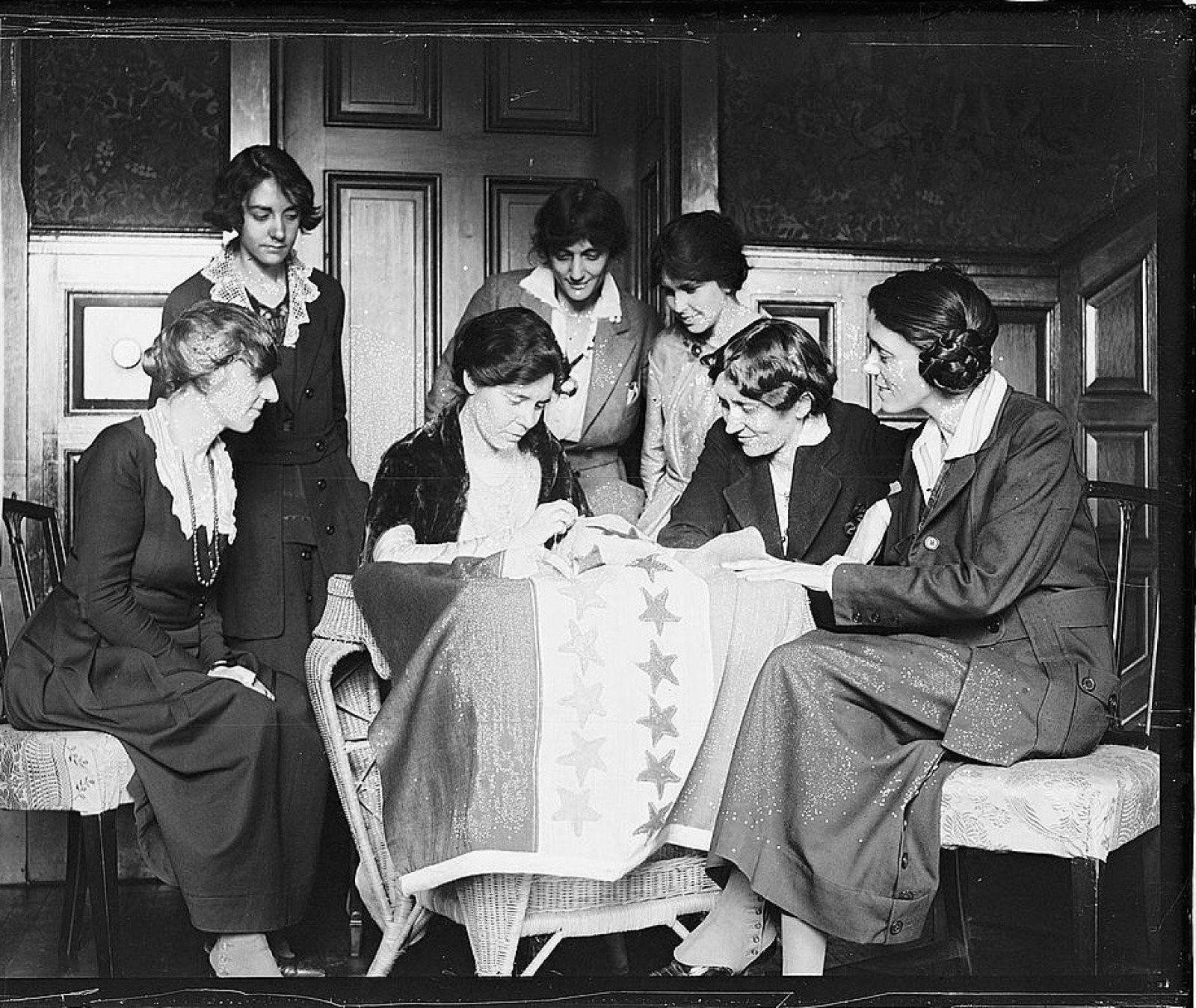
Alice Paul sewing stars on suffrage flag. Source: Sigal Museum
Text In the 1960s and 1970s during the Civil Rights Movement in the United States a significant example of quilting as a form of solidarity and resistance within the AfricanAmerican community was The Freedom Quilting Bee It was a cooperative quilting proj
In the 1960s and 1970s, during the Civil Rights Movement in the United States a significant example of quilting as a form of solidarity and resistance within the African-American community was The Freedom Quilting Bee. It was a cooperative quilting project established in 1966 by a group of African-American women in the rural community of Alberta, Alabama. The Freedom Quilting Bee aimed to create economic self-sufficiency and financial independence for African-American women in the region. The cooperative produced handmade quilts that were sold to support the civil rights movement and improve the economic conditions of the community. The quilts were unique, often featuring bold and vibrant designs, and represented the rich cultural heritage and artistic traditions of African-American quilting. (4)
Image Freedom Quilting Bee women around quilt Birmingham Ala Public Library Archives 25542 png
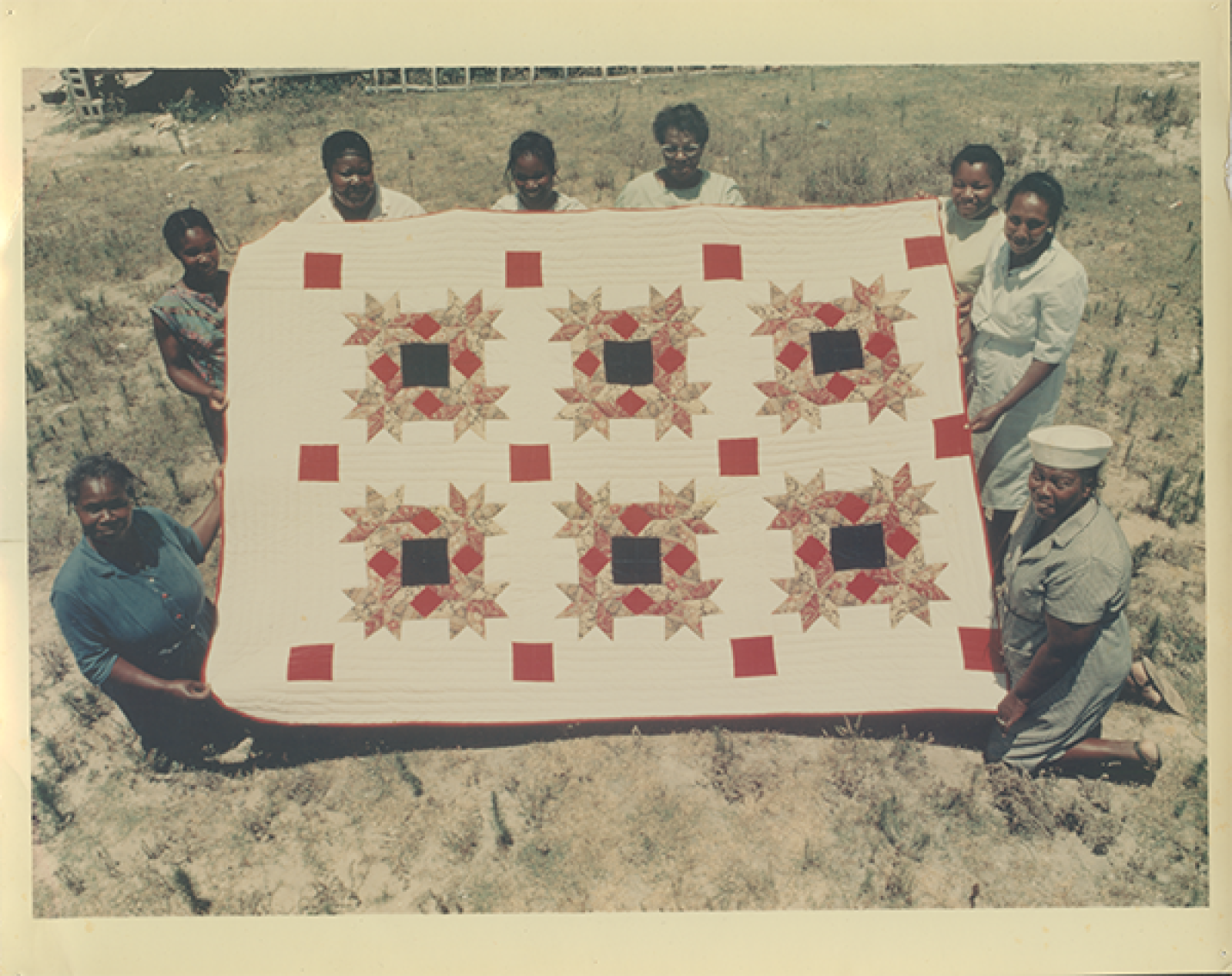
The Freedom Quilting Bee, women around the quilt. Birmingham, Ala.
Public Library Archives, 255.4.2
Text Another more recent example is the AIDS Memorial Quilt In the 1980s and 1990s the AIDS Memorial Quilt emerged as a powerful symbol of remembrance activism and solidarity in the face of the AIDS crisis Panels of the quilt were created by friends famil
Another more recent example is the AIDS Memorial Quilt. In the 1980s and 1990s, the AIDS Memorial Quilt emerged as a powerful symbol of remembrance, activism, and solidarity in the face of the AIDS crisis. Panels of the quilt were created by friends, families, and communities to memorialize loved ones lost to the disease. It served as a visual representation of the human toll of AIDS and a call for awareness, compassion, and action. (5)
Image aidsquiltjpeg
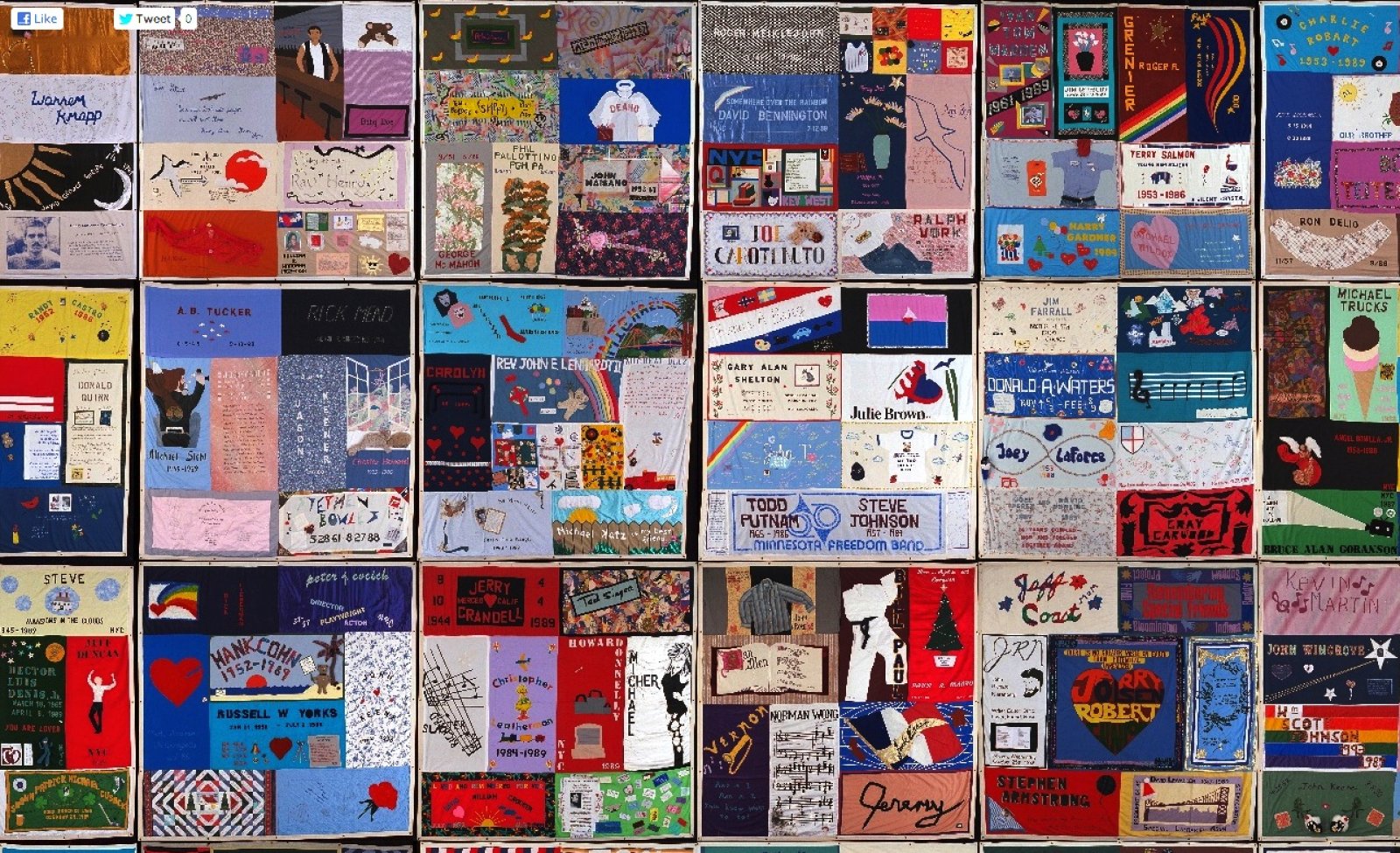
Source: flgowrley.wordpress.com/2017/11/18/iash-twitter-takeover-favourite-collages-3-the-names-project-aids-memorial-quilt/
Text Quilting activism today comes in different forms Some programs teach quilting skills in exchange for economic support Quilters often create quilts for those in need or donate them to raise funds for community programs Books like Katherine Bells Quilt
Quilting activism today comes in different forms. Some programs teach quilting skills in exchange for economic support. Quilters often create quilts for those in need or donate them to raise funds for community programs. Books like Katherine Bell's Quilting for Peace offer quilters a range of charitable causes to support. (6)
Text In my work the quilt not only serves as a physical object but also acts as a container for the archive I am presenting At this point I would describe my project as a landscape archive because the quilt functions as a tangible space to preserve memori
In my work, the quilt not only serves as a physical object but also acts as a container for the archive I am presenting. At this point, I would describe my project as a landscape archive, because the quilt functions as a tangible space to preserve memories, carefully documented events, and artworks, recorded, collected, and created to resemble again and again how different forms of resistance were and still are important tools for changing the status quo. The quilt and objects on it form a new landscape; a quilt like a desert, forest bushes, dried lava, or traffic in an urban environment, invites you to walk on it and explore various details of the archive, sometimes giving the viewer a sign to sit or lie down, walk around or simply stand still and listen to the sounds that periodically appear.
Text Whereas the traditional notion of archiving is to be understood as the inward movement of collecting things finding bits and pieces bringing them together guarding them in a safe and stable space in my case archiving means to actually use and consume
Whereas the traditional notion of archiving is to be understood “as the inward movement of collecting things: finding bits and pieces, bringing them together, guarding them in a safe and stable space”, in my case archiving means “to actually use and consume things, to keep them in, or bring them into circulation, and throw them forth, into a shared and distributed process that operates based on diffusion, not consolidation, not memory, and towards creation, not conservation”. (7) In other words, my archive is a living organism that is in constant motion. Its parts can change their position in space, can become part of something else, and sometimes can even be removed temporarily from the organism. Even its skin will gradually change, by spreading out in different directions and becoming new parts of itself without top or bottom over time.
Image 20230828LucyMA06CrJiyeLeeFulljpg
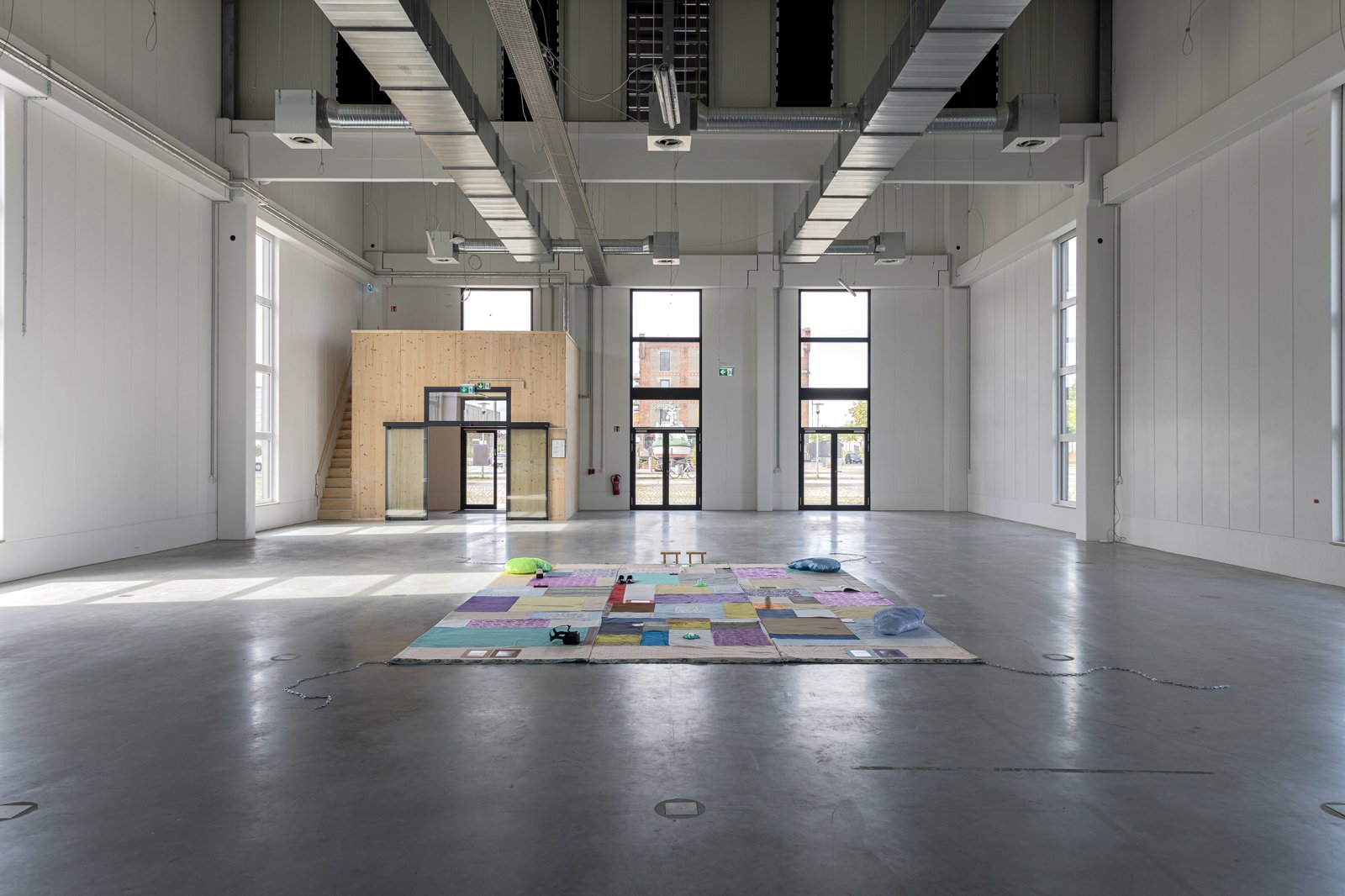
Liudmila Savelyeva, Tracing Resistance, HfK Bremen 2023. Photo by Jiye Lee
Text Deleuze Gilles Guattari Felix 141440 The Smooth And The Striated A Thousand Plateaus London 1987Ibid PP 476477Hollander Stacy C Speaking for womens suffrage through a quilt JSTOR Blog 2004 httpsaboutjstororgblogteachingwithartstorspeakingforwomensCal
- Deleuze, Gilles; Guattari, Felix. 14.1440: The Smooth And The Striated, A. Thousand Plateaus. London: 1987.
- Ibid. PP. 476-477.
- Hollander, Stacy C.. Speaking for women’s suffrage through a quilt. JSTOR Blog. 2004. https://about.jstor.org/blog/teaching-with-artstor-speaking-for-womens-…
- Callahan, Nancy. The Freedom Quilting Bee: Folk Art and the Civil Rights Movement. University of Alabama Press. 2005.
- AIDS Memorial Quilt. https://www.aidsmemorial.org/quilt-history
- Pauls, Melanie Anne. Piecing together creativity: feminist aesthetics and the crafting of quilts. College of Liberal Arts & Social Sciences. Theses and Dissertations. 2014.
- Pad.ma. 10 Theses on the Archive. Archives on Show. Revoicing, Shapeshifting, Displacing – A Curatorial Glossary. Archive Books.2022. PP. 17-21.
Text sympathizinggraftingrecollectingtransformingreassemblingmobilizingreenactingspinning threadsrepairingallegorizingcommoningreentanglingparallelizingghostingmetabolizingshapeshiftingtransposingsuspendingdisplacingretemporalizingtransfictioningrevoicing
sympathizing
grafting
recollecting
transforming
reassembling
mobilizing
reenacting
spinning threads
repairing,
allegorizing,
commoning
reentangling
parallelizing
ghosting
metabolizing
shapeshifting
transposing
suspending
displacing
retemporalizing
transfictioning
revoicing (1)
Text Today one can discuss how the concept of the archive and archival practices have significantly expanded and transformed over the past decades Working on my project Tracing Resistance I am trying to create from the repurposed materials of my old and n
Today, one can discuss how the concept of the archive and archival practices have significantly expanded and transformed over the past decades. Working on my project Tracing Resistance, I am trying to create, from the repurposed materials of my old and new works, a mobile archive, that could be thought of “not as something static, a container of knowledge, but a set of materials that would talk to one another and could constantly be re-animated and put into the parallel conversation to produce new meaning and relationships.” (2) In other words, by reconstructing existing materials and montage it becomes a living archive that is open to transformations over time.
Text In recent years there has been a new understanding of knowledge organization thanks to Didi Hubermans work on the productivity of Aby Warburgs Mnemosyne Atlas The atlas stands out for its nonlinear spatial organization its varied ways of navigating a
In recent years, there has been a new understanding of knowledge organization thanks to Didi Huberman's work on the productivity of Aby Warburg's Mnemosyne Atlas. The atlas stands out for its non-linear spatial organization, its varied ways of navigating and interpreting the connections between objects, its ability to work with groups of images, and its associative montage to combine heterogeneous elements in the same space. Thus, in addition to its role as an object of study, the atlas becomes a method of working with visual materials, revealing the principles of system organization, the interaction of images, and the mechanisms of historical knowledge formation. The difference between this concept from historical chronicles also lies in the possibility of visualizing not only spatial, but also temporal relations, which allows us to simultaneously participate in the interpretation of both synchronic and diachronic aspects. “Since Warburg, not only the atlas has profoundly modified the forms–and therefore, the contents of all the "cultural sciences" or human sciences, but has also encouraged a great number of artists to rethink completely, in the form of compilation and reassembly, the modalities according to which the visual arts are made and presented today.” (3)
Image Aby Warbergjpeg

Aby Warburg, Mnemosyne Atlas, Panel 48. Fortuna. Symbol of the struggle of the self-liberating man (merchant), 1924-1929 (unfinished). Source: Cornell University Library, The Warburg Institute.
Text In ancient Greek mythology Mnemosyne is the goddess personifying memory Mnemosyne Atlas is dedicated to the theme of memory and its reconstruction Warburg assumes that memory generally chooses the instantaneous image rather than narrative as its medi
In ancient Greek mythology, Mnemosyne is the goddess personifying memory. Mnemosyne Atlas is dedicated to the theme of memory and its reconstruction. Warburg assumes that memory generally chooses the instantaneous image rather than narrative as its mediator. The Mnemosyne Atlas itself, on the other hand, is a history of the symbolic expressions of image memory. (4)
Text Valentin Dyakonov in his short text for Anna Titovas exhibition Exchange Point explains that artists engagement with archives is a relatively new trend notably observed in art history through works like Aby Warburgs Mnemosyne Atlas The use of archiva
Valentin Dyakonov in his short text for Anna Titova’s exhibition Exchange Point explains that artist’s engagement with archives is a relatively new trend, notably observed in art history through works like Aby Warburg's Mnemosyne Atlas. The use of archival elements has allowed artists to delve into “the archaeology of knowledge” and historical image mediation using a critical narrative. In this way, the archive resembles a collage, both highlighting the composite nature of visuals influenced by Frankenstein's approach. (5)
Image AnnaTitovaExchangePointjpeg

Anna Titova, The point of exchange, Artwin Gallery 2016. Source: https://en.artwingallery.com/exhibitions/punkt-obmena-3
Image parallelencyclopediavol1reprintbybatiasuter9016061400xjpeg
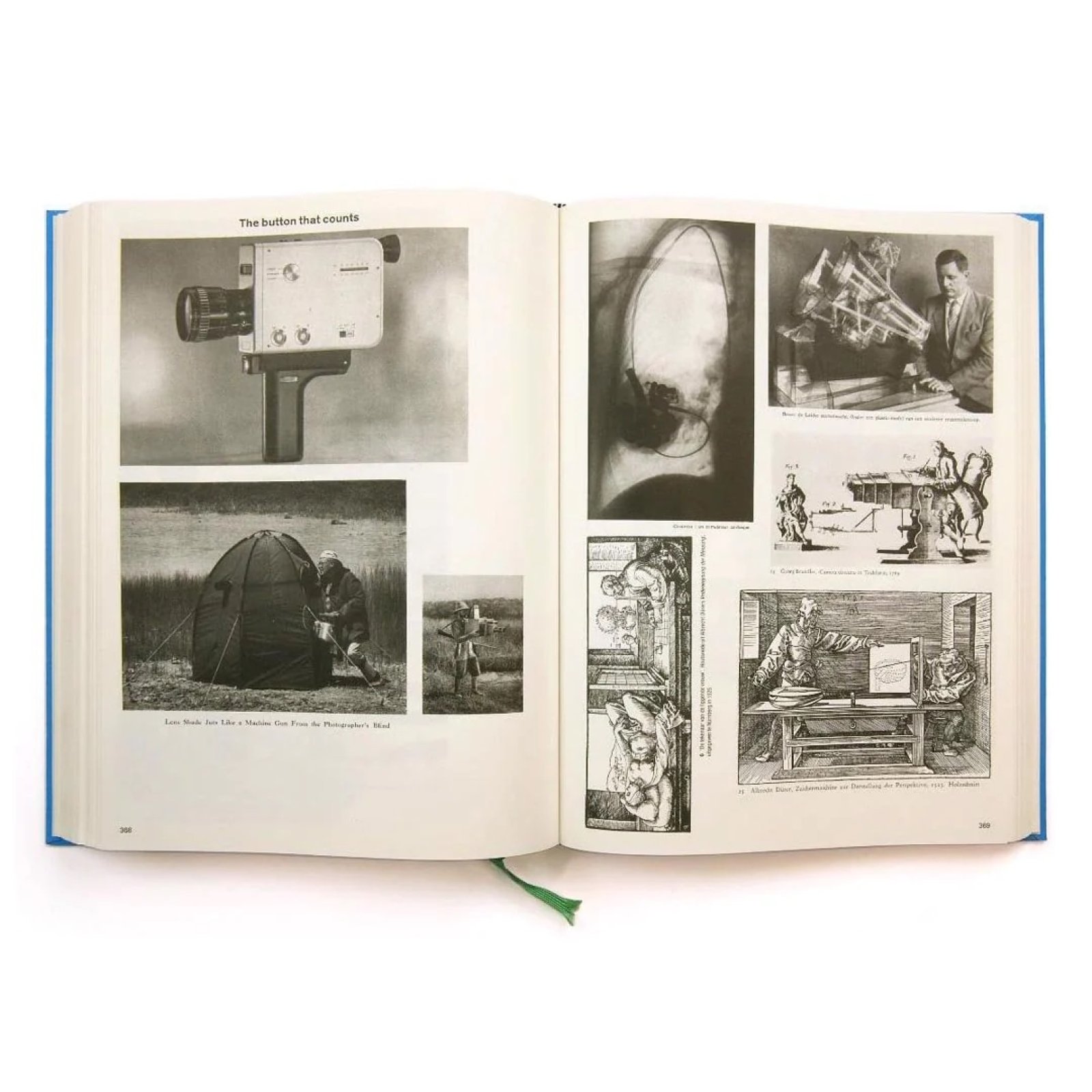
Parallel Encyclopedia Vol.1 - reprint - by Batia Suter. Source: https://www.tipi-bookshop.be
Text Another example of a productive form of knowledge organization are the works of Batia Suter a contemporary SwissDutch artist known for her innovative approach to imagemaking and her exploration of visual archives Her practice involves collecting arra
Another example of a productive form of knowledge organization are the works of Batia Suter, a contemporary Swiss-Dutch artist known for her innovative approach to image-making and her exploration of visual archives. Her practice involves collecting, arranging, and manipulating existing images from various sources to create new and often surreal visual narratives
Suter's work revolves around the concept of the archive and the manipulation of found images. She extensively collects images from books, magazines, newspapers, and the internet, and then meticulously combines and recontextualizes them. Her art blurs the lines between reality and fiction, often resulting in uncanny and dreamlike compositions.
One of Suter's notable projects is Parallel Encyclopedia, where she assembles images into thematic categories to create an encyclopedia that challenges conventional knowledge hierarchies. This work speaks to her interest in the interplay between images and their associations, similar to the way Aby Warburg's Mnemosyne Atlas brought together images from diverse sources to explore visual connections and cultural memory.
Image 20230828LucyMA71CrJiyeLeewebjpg

Liudmila Savelyeva, Tracing Resistance, HfK Bremen 2023.
Photo by Jiye Lee
Text Working on my archive and structuring it I consistently revisited the definitions of conceptualism and aimed to reinterpret them It is widely acknowledged that the primary distinction of conceptualism from the other 20thcentury art movements lies in
Working on my archive and structuring it, I consistently revisited the definitions of conceptualism and aimed to reinterpret them. It is widely acknowledged that the primary distinction of conceptualism from the other 20th-century art movements lies in the dominance of the idea over form and material. Conceptual art objects can take on many forms, including readymades, documentation such as photographs, video materials, tables, diagrams, and text. Another approach often used in conceptualism is placing an object in an unconventional for it context to create a new meaning or perspective. (6) "Within a broader interpretation, 'conceptualism' will signify any attempt to depart from the creation of art objects as material entities intended for contemplation and aesthetic evaluation, and to transition towards uncovering and shaping the conditions that dictate the viewer's perception of art, the artist's process of creation, their correlation with elements of the surrounding environment, their temporal status, and so on". (7)
Text In the USSR conceptualism emerged around the late 1960s and held the status of unofficial art This is precisely why such art could only be exhibited in unorthodox places such as communal flats studios attics of residential buildings etc One could say
In the USSR, conceptualism emerged around the late 1960s and held the status of "unofficial" art. This is precisely why such art could only be exhibited in unorthodox places, such as communal flats, studios, attics of residential buildings, etc. One could say that the artistic community became hermetically sealed. Artists simultaneously found themselves performing several roles: they produced art, consumed it, and criticized it. "Art was directed inwards, with themes for artistic exploration revolving around issues of more interest to the artists concerned". (8)
Text Moscow conceptualist art served as not only a form of protest but also a means of escape from artistic and personal constraints characteristic of the period 9
"Moscow conceptualist art served as not only a form of protest but also a means of escape from artistic and personal constraints characteristic of the period" (9)
Text Since it is believed that conceptualism in nonconformist Soviet culture have originated and flourished in the capital it later became known as Moscow Conceptualism a name adopted after the publication in 1979 of an article published by Boris Groys un
Since it is believed that conceptualism in non-conformist Soviet culture have originated and flourished in the capital, it later became known as Moscow Conceptualism, a name adopted after the publication in 1979 of an article published by Boris Groys under the title "Moscow Romantic Conceptualism". Notable among the most famous representatives of Moscow Conceptualism was Ilya Kabakov. "One of the cross-cutting themes in Kabakov's art was emptiness, doors opening into white, a blank sheet at the end of albums about ten characters, white paintings. Emptiness as cosmos ready to be spawned, emptiness as a silence into which the artist listens, and emptiness as a frightening stillness. The theme of emptiness, dating back to the Russian avant-garde, united the work of the Moscow conceptualists, and in many ways was connected with reflection on the Soviet reality". (10)
Text In other words the emergence of conceptual art in the Soviet Union can be seen as a form of resistance to ideological art which is the official art of the time Olga Shmagina writes about the same in her thesis The Work Of Irina Nakhova In The Context
In other words, the emergence of conceptual art in the Soviet Union can be seen as a form of resistance to ideological art, which is the official art of the time. Olga Shmagina writes about the same in her thesis The Work Of Irina Nakhova In The Context Of Late Moscow Conceptualism. She refers to the researcher of Moscow conceptual art, Ekaterina Bobrinskaya, who links the artists' inclination to work with the idea of collectivization to an awareness of the "complete penetration of ideology into the space of life" and the emergence of the concept of "conceptuality" of the surrounding world. This finds confirmation in the words of Andrei Monastyrsky in the trialogue between him, Ilya Kabakov, and Joseph Brodsky: "Conceptualism in the Soviet Union is not accidental; it is inherent to our social sphere, where the place of objectivity is very small. We essentially live in a conceptual space". (11)
At the same time, in a conversation between Kabakov and Groys, the latter says that “we live among archives, we live within a collection. In fact, virtually all the objects we engage with are described, characterized, or somehow modeled”. (12)
Text we live among archives we live within a collection In fact virtually all the objects we engage with are described characterized or somehow modeled
"we live among archives, we live within a collection. In fact, virtually all the objects we engage with are described, characterized, or somehow modeled"
Text The world is one big archive which consists of subarchives They are either constantly being added to or reorganized into new archives
The world is one big archive, which consists of sub-archives. They are either constantly being added to or reorganized into new archives.
Image 20230828LucyMA62CrJiyeLeewebjpg

Liudmila Savelyeva, Tracing Resistance, HfK Bremen 2023.
Photo by Jiye Lee
Text Archives on Show Revoicing Shapeshifting Displacing A Curatorial Glossary Ed Beatrice von Bismarck Archive Books 2022 PP 1141Chateign Yann Miessen Markus The Archive as a Productive Space of Conflict Introduction Productive spaces of conflict Stenbe
- Archives on Show. Revoicing, Shapeshifting, Displacing – A Curatorial Glossary. Ed. Beatrice von Bismarck. Archive Books. 2022. PP. 1-141.
- Chateigné, Yann; Miessen, Markus. The Archive as a Productive Space of Conflict. Introduction: Productive spaces of conflict. Stenberg press. 2016. P. 9.
- Didi-Huberman, Georges. The Heritage of our Time: The Mnemosyne Atlas. Uddfederico Soriano: Ud24_T05. P.1. https://issuu.com/uddfedericosoriano/docs/ud24_t05_imprimir_p_ginaseng
- Philippe-Alain, Michaud. Aby Warburg and the Image in Motion. Transl. by Sophie Hawkes. Boston: MIT Press. 2004.
- Dyakonov, Valentin. Cognitive Architecture. Artwin Gallery. 2016. Cf. P.22.
- Shmagina, Olga. The Work Of Irina Nakhova In The Context Of Late Moscow Conceptualism. Moscow. 2011. https://conceptualism.letov.ru/NAKHOVA/diplom/I-1.html
- Groys, Boris. Moscow Romantic Conceptualism. WAM № 15-16. Moscow Conceptualism. 2005. P. 343.
- Shmagina, Olga. The Work Of Irina Nakhova In The Context Of Late Moscow Conceptualism. Moscow. 2011. https://conceptualism.letov.ru/NAKHOVA/diplom/I-2.html
- Eugenia Ivanova. Moscow Romantic Conceptualism 101: The Art of Heightened Senses. https://www.byarcadia.org/post/moscow-romantic-conceptualism-101-the-ar…
- Persheeva, Alexandra; Leonova, Galina. Phantom communication sessions: Words to the silence. Moscow. 2017. P. 12.
- Shmagina, Olga. The Work Of Irina Nakhova In The Context Of Late Moscow Conceptualism. Moscow. 2011. https://conceptualism.letov.ru/NAKHOVA/diplom/I-2.html
- Kabakov, Ilya; Groys, Boris. Dialogues. Monoskop. Vologda. 2010. P. 128. https://monoskop.org/images/0/07/Kabakov_Groys_Dialogi_2010.pd